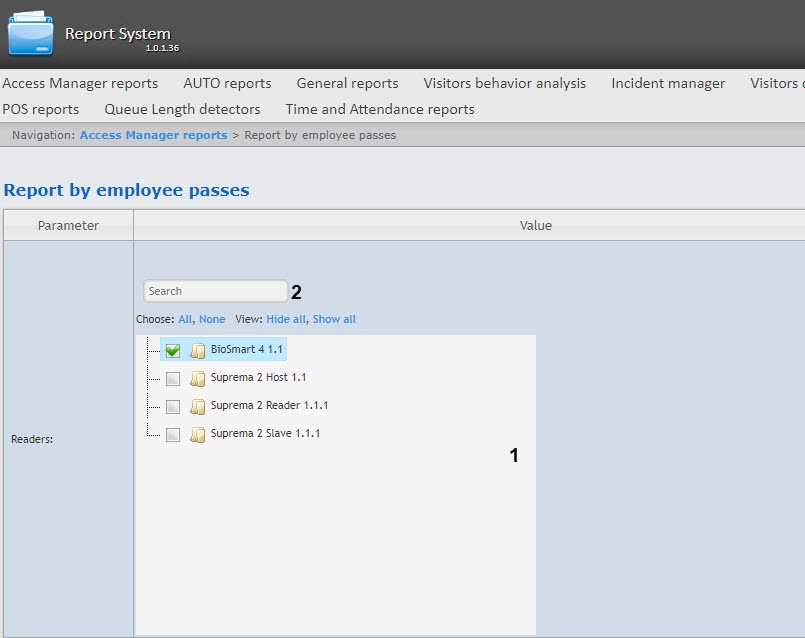Go to documentation repository
Documentation for WEB Report System PSIM 1.0.1.
Previous page Next page
The Report by employee passes displays all interactions between the selected employee and the selected readers. The report allows you to track the movement of the selected employee within a specified area.
To generate the report, select the Report by employee passes from the list of Access Manager reports (see Selecting the type of Access Manager report) and specify the report parameters in the opened form.
In the Readers area (1), set the checkboxes next to those access points, the information on which should be displayed in the report.
Attention!
This field displays only the access points which are added to any access level in the Access Manager module (see Creating access levels).
For the rs user, it is enough to create an access level with all access points. For other users, it is necessary to assign access levels in the Access Manager module (see Assigning access levels to a user).
- You can search for an access point using the search field. For this, in the search field (2), enter the name of the access point. Click All to select all found access points, click None to deselect. If the search field is blank, click All to select all possible access points. Click Hide all to hide the access points structure. Click Show all to expand the access point structure.
In the Choose report columns area (3), set the checkboxes next to those columns that should be displayed in the report. You can also change the order of the columns: left-click and hold the column name and drag it higher or lower relative to other columns. Click All to select all columns. Click None to deselect. Click Hide all to hide the columns structure. Click Show all to expand the columns structure.
From the Orientation drop-down list (4), select the report display orientation: Portrait (vertical) or Landscape (horizontal).
Attention!
- In the Portrait orientation, you can select up to 5 columns.
- In the Landscape orientation, you can select up to 7 columns.
- From the Sort drop-down list (5), select the sorting type: In alphabetical order or By department.
- Set the Show only last access checkbox (6) to show only the last access of employees.
- Set the Show only first access checkbox (7) to show only the first access of employees.
From the Period drop-down list (8) select the time period for which the report should be created. If the Custom or Custom 2 period is selected, enter the date of start and end periods for which the report should be created in the from and to fields using the Calendar tool. Click the button near the corresponding field to use the Calendar tool. For the Custom 2 time period, it is also necessary to enter the time of start and end period using the button.
- In the Departments/users area (9), set the checkboxes next to those departments and employees, the information on which should be displayed in the report.
You can search for departments and employees using the search field. For this, in the search field (10), enter the name or the surname of the employee, or the name of the department fully or partially, click the Search button (11) to search for employees or departments. Click the Clear search tree button to clear the search results. Click All to select all found employees or departments. Click None to deselect. If the search field is blank, when clicking All, you will need to enter more than 4 characters. Click Hide all to hide the department structure. Click Show all to expand the department structure.
To create a report, click the Execute button (13). As a result, the report with the specified parameters will be displayed.
Example of a report in the Portrait orientation:
All possible report fields are described in the table.
| Field name | Description |
|---|---|
| No. | Line number |
| Full name | Employee's full name |
| Name | Employee's first name |
| Surname | Employee's last name |
| Patronymic | Employee's patronymic |
| Position | Employee's position |
| Company/Department | Company/Department where employee works |
| Department | Department where employee works |
| Face concealment | Glasses, masks and other options of face concealment |
| Temperature | Face temperature in degrees Celsius from thermal camera or external system |
| Access levels | Employee access level |
| License plate number | Employee's car license plate number |
| Car | Employee's car brand |
| Card number | Employee access card number |
| Card code | Employee access card code |
| Date of card issue | Date when the card was issued to the employee |
| Access point | Access point through which the employee passed |
| Date | Date of passage |
| Date and time | Date and time of passage |
| Time | Time of passage |
| Phone | Employee's phone number |
| Comment | Comment |
| Card start date | Employee's card start date |
| Card expiration date | Employee's card expiration date |
| Card PIN code | Employee's card PIN code |
| External ID | Employee's external ID |
| Personnel number | Employee's personnel number |
| Enter-Exit | Name of enter and exit |
| The Employees in total line displays the number of captured employee faces, not the number of unique faces | |



